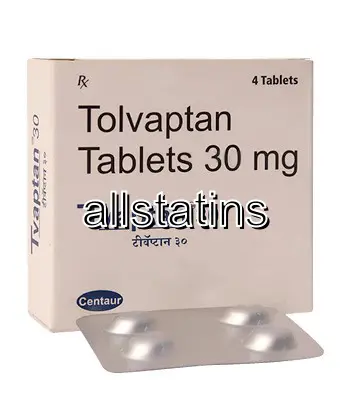| Package | Dosage | Price | Price per Dose | |
|---|---|---|---|---|
| Dosage: 15mg | ||||
| 180 pill | 15mg | NZD3,289.36 | NZD18.27 | |
| 120 pill | 15mg | NZD2,230.07 | NZD18.58 | |
| 90 pill | 15mg | NZD1,700.42 | NZD18.89 | |
| 60 pill | 15mg | NZD1,152.19 | NZD19.20 | |
| 30 pill | 15mg | NZD585.37 | NZD19.51 | |
| 20 pill | 15mg | NZD396.43 | NZD19.82 | |
| 10 pill | 15mg | NZD201.30 | NZD20.13 | |
| Dosage: 30mg | ||||
| 120 pill | 30mg | NZD2,905.29 | NZD24.22 | |
| 90 pill | 30mg | NZD2,217.68 | NZD24.65 | |
| 60 pill | 30mg | NZD1,505.29 | NZD25.09 | |
| 30 pill | 30mg | NZD758.82 | NZD25.31 | |
| 20 pill | 30mg | NZD511.03 | NZD25.55 | |
| 10 pill | 30mg | NZD257.05 | NZD25.71 | |

Tolvaptan Description
Overview of Tolvaptan
Tolvaptan is a medication primarily used to treat conditions related to fluid retention, such as hyponatremia, and certain types of kidney disease. It belongs to a class of drugs known as vasopressin receptor antagonists. By blocking the action of vasopressin, a hormone responsible for water retention, Tolvaptan helps to promote water excretion without losing electrolytes, which makes it effective in managing specific medical conditions.
How Tolvaptan Works
The medication works by selectively inhibiting the vasopressin V2 receptors in the kidneys. This action prevents water reabsorption in the collecting ducts, leading to increased free water excretion. As a result, the drug helps to correct low sodium levels in the blood caused by excess water retention. This mechanism makes Tolvaptan particularly useful in treating hyponatremia associated with conditions like syndrome of inappropriate antidiuretic hormone secretion (SIADH) and heart failure.
Uses and Indications
Tolvaptan is commonly prescribed for patients with hyponatremia that is resistant to other treatments. It is also used in the management of autosomal dominant polycystic kidney disease (ADPKD), a genetic disorder characterized by the growth of numerous cysts in the kidneys. For ADPKD, Tolvaptan slows the progression of cyst development and preserves renal function over time.
Potential Benefits
One of the main advantages of Tolvaptan is its targeted action, which helps to normalize sodium levels efficiently while minimizing electrolyte imbalances. Patients often experience relief from symptoms related to fluid retention, such as swelling and shortness of breath. For those with ADPKD, the medication can delay the decline in kidney function, reducing the need for dialysis or transplant eventually. Additionally, the oral administration provides convenience compared to injectable therapies.
Side Effects and Risks
Despite its benefits, Tolvaptan can cause side effects. Common adverse reactions include thirst, dry mouth, increased urination, and weakness. Some patients may experience more serious effects such as liver damage, which necessitates regular liver function monitoring during treatment. Because of its influence on electrolyte balance, careful monitoring of sodium levels is essential to prevent overly rapid correction, which could lead to neurological complications.
Precautions and Considerations
Prior to starting Tolvaptan, doctors evaluate patients thoroughly to determine suitability. It is not recommended for individuals with hypovolemic hyponatremia or liver impairment. Patients with underlying, uncontrolled health issues should discuss potential risks with their healthcare provider. Proper dosage adjustment and vigilant monitoring are critical to ensure safe and effective therapy.
Conclusion and User Experience
Many individuals find Tolvaptan to be an effective solution for managing fluid-related conditions and slowing the progression of kidney disease. Its targeted mechanism offers a significant advantage over traditional diuretics in specific cases. Nonetheless, the need for consistent medical supervision and awareness of potential side effects makes it essential that patients follow prescribed guidelines closely. Overall, Tolvaptan remains a valuable option for suitable candidates seeking to improve quality of life through better control of their condition.
